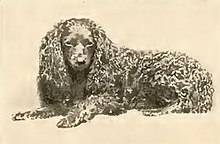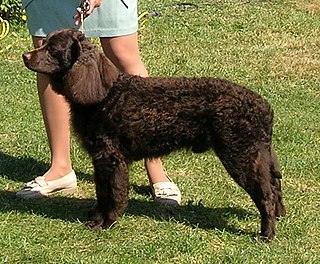
The American Water Spaniel is a breed of spaniel which originated in the United States. It was developed in the state of Wisconsin during the 19th century from a number of other breeds, including the Irish and English Water Spaniels. The breed was saved by Dr. Fred J. Pfeifer, who set up the breed club and standard, and whose work led to recognition for the breed by the United Kennel Club, and later, the American Kennel Club. While they are the state dog of Wisconsin, they remain a rare breed.

The Clumber Spaniel is a breed of dog of the spaniel type, developed in the United Kingdom. It is the largest of the spaniels, and comes in predominantly white with either lemon or orange markings. The name of the breed is taken from Clumber Park in Nottinghamshire where the breed was first developed. It is a gundog that specialises in hunting in heavy cover. They are gentle and loyal, and can act aloof with strangers. They have several habits which could be considered disadvantages, including a constant shedding of its coat and snoring.

The Cavalier King Charles Spaniel is a British breed of toy dog of spaniel type. Four colours are recognised: Blenheim, tricolour (black/white/tan), black and tan, and ruby; the coat is smooth and silky. The lifespan is usually between eight and twelve years.

Cocker Spaniels are dogs belonging to two breeds of the spaniel dog type: the American Cocker Spaniel and the English Cocker Spaniel of which are commonly called simply Cocker Spaniel in their countries of origin. In the early 20th century, Cocker Spaniels also included small hunting spaniels.

The Pekingese is a breed of toy dog, originating in China. The breed was favored by royalty of the Chinese Imperial court as a companion dog, and its name refers to the city of Peking (Beijing) where the Forbidden City is located. The breed has several characteristics and health issues related to its unique appearance. Because of its desirable characteristics, the Pekingese has been part of the development of designer crossbreeds, such as the Peekapoo and Peke-a-tese.

Maltese dog refers both to an ancient variety of dwarf canine from Italy and generally associated also with the island of Malta, and to a modern breed of dog in the toy group. The contemporary variety is genetically related to the Bichon, Bolognese, and Havanese breeds. The precise link, if any, between the modern and ancient species is not known. Nicholas Cutillo suggested that Maltese dogs might descend from spitz-type canines, and that the ancient variety probably was similar to the latter Pomeranian breeds with their short snout, pricked ears, and bulbous heads. These two varieties, according to Stanley Coren, were perhaps the first dogs employed as human companions.
Toy dog traditionally refers to a very small dog or a grouping of small and very small breeds of dog. A toy dog may be of any of various dog types. Types of dogs referred to as toy dogs may include spaniels, pinschers and terriers that have been bred down in size. Not all toy dogs are lap dogs.

A lap dog or lapdog is a dog that is both small enough to be held in the arms or lie comfortably on a person's lap and temperamentally predisposed to doing so. Lapdog is not a specific breed, but a generic term for a type of dog that is small in size and friendly towards humans.

The Field Spaniel is a medium-sized dog breed of spaniel type. They were originally developed to be all-black show dogs in the late 19th and early 20th centuries and were unpopular for work as a hunting dog. However, during the mid-20th century they were redeveloped as a longer-legged dog that was more suitable to be used for field work. They are now considered to be a rare breed, and are registered as a Vulnerable Native Breed by The Kennel Club.

The Tibetan Spaniel is a breed of assertive, small dogs originating in Tibet. This breed is not a spaniel in the original meaning of the term; its breeding differs from other spaniels, and unlike true spaniels, which are gun dogs, the Tibetan spaniel is a companion dog. The spaniel name may have been given due to its resemblance to the bred-down lapdog versions of the hunting spaniels, such as the Cavalier King Charles spaniel.
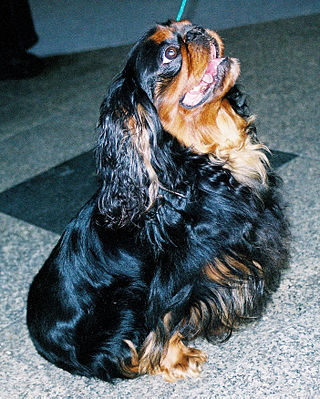
The King Charles Spaniel is a small dog breed of the spaniel type. In 1903, the Kennel Club combined four separate toy spaniel breeds under this single title. The other varieties merged into this breed were the Blenheim, Ruby and Prince Charles Spaniels, each of which contributed one of the four colours available in the breed.

The Boykin Spaniel is a medium-sized breed of dog, a Spaniel bred for hunting wild turkeys and ducks in the Wateree River Swamp of South Carolina, in the United States. It is the state dog of South Carolina, where it was discovered and further developed by hunters in the 1900s. 1 September, 1984 is Boykin Spaniel Day in South Carolina.
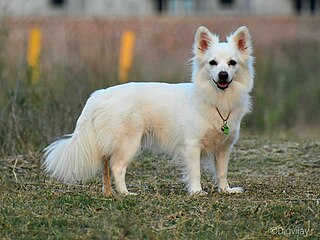
The Indian Spitz is a spitz-type dog breed belonging to the utility group. The Indian Spitz was one of the most popular dogs in India in the 1980s and 1990s when India's import rules made it difficult to import dogs of other breeds.

The Sussex Spaniel is a breed of dog native to Sussex in southern England. It is a low, compact spaniel and is as old a breed as and similar in appearance to the Clumber Spaniel. They can be slow-paced, but can have a clownish and energetic temperament. They suffer from health conditions common to spaniels and some large dogs, as well as a specific range of heart conditions and spinal disc herniation.

The Tweed Water Spaniel, or Tweed Spaniel, is a breed of dog extinct since the 19th century. It is best known for being involved in the early development of the modern Curly Coated Retriever and Golden Retriever breeds of dogs. They were described as generally brown, athletic dogs from the area around Berwick-upon-Tweed near the River Tweed and close to the Scottish Borders. A type of water dog, the breed was not well known outside the local area. This breed may have been created by crossing local water dogs with imported St. John's water dog, another breed which is also now extinct.
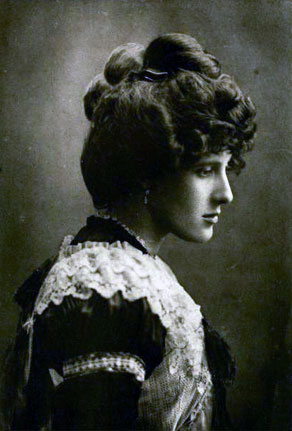
Judith Anne Dorothea Blunt-Lytton, 16th Baroness Wentworth, also known as Lady Wentworth, was a British peer, Arabian horse breeder and real tennis player. As the owner of the Crabbet Arabian Stud from 1917 to 1957, her influence on Arabian horse breeding was profound, with over 90 percent of all Arabian horses in the world today carrying lines to Crabbet bloodstock in their pedigrees.

The French Spaniel is a breed of dog of the Spaniel-like setter. It was developed in France and Canada as a hunting dog, descended from dogs of the 14th century. Popular with royalty during the Middle Ages, it nearly became extinct by the turn of the 20th century but was saved by the efforts of Father Fournier, a French priest. One of the largest breeds of Spaniel, it typically has a white coat with brown markings. It is a friendly breed that has few health issues, but can be affected by a syndrome called acral mutilation and analgesia. The breed is recognised by Canadian and international kennel clubs but not by The Kennel Club (UK). The American Kennel Club has included the breed in its Foundation Stock Service, the first step to full recognition.

The German Spaniel, also known as the Deutscher Wachtelhund, is a breed of dog that was developed in Germany around 1890, and is used as a hunting dog. Descended from the old German breed, the Stöberer, which became popular with commoners following the Revolutions of 1848 in the German states, who required a versatile hunting dog. Stoeberer is now a type of hunting dog in Germany with the Wachtelhund being its sole member. The breed is not very well known outside of Germany, but was recognised by the United Kennel Club in 1996.
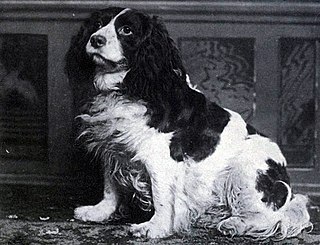
The Norfolk Spaniel or Shropshire Spaniel is an extinct breed of dog since the early 20th century. It was originally thought to have originated from the work of one of the Dukes of Norfolk, but this theory was disproven after being in doubt during the later part of the 19th century. The term was used to designate springer type spaniels that were neither Sussex nor Clumber Spaniels, and attempts were made to use it to specify a breed that would later become known as the English Springer Spaniel.
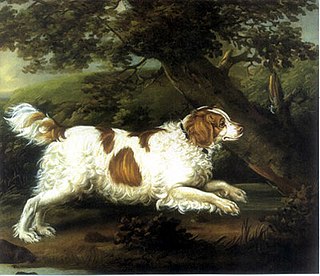
The English Water Spaniel is a breed of dog that has been extinct since the first part of the 20th century, with the last specimen seen in the 1930s. It was best known for its use in hunting waterfowl and for being able to dive as well as a duck. It is described as similar to a Collie or to a cross between a Poodle and a Springer Spaniel with curly fur and typically in a white and liver/tan pattern.
